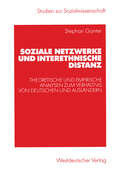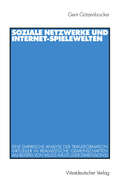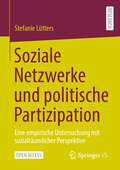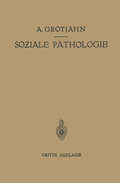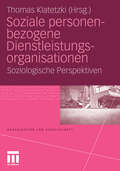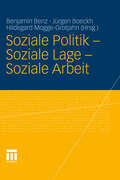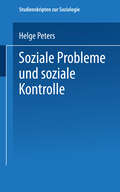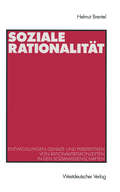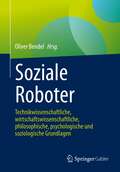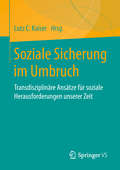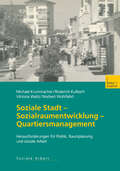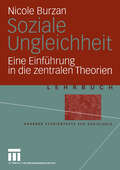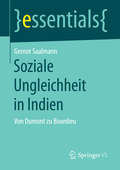- Table View
- List View
Soziale Netzwerke und interethnische Distanz: Theoretische und empirische Analysen zum Verhältnis von Deutschen und Ausländern (Studien zur Sozialwissenschaft)
by Stephan GanterWorauf ist es zurückzuführen, dass bei manchen Deutschen eher positive und bei anderen eher negative Reaktionen gegenüber Immigranten zu beobachten sind? Wie lassen sich Grenzziehungen und soziale Distanzen gegenüber ethnischen Minderheiten erklären? Diese wichtigen, theoretisch und empirisch aber immer noch weitgehend ungeklärten Fragen stehen im Mittelpunkt dieses Buchs. Der darin entwickelte Ansatz zur Erklärung interethnischer Distanzen zeichnet sich vor allem dadurch aus, dass den bislang meist vernachlässigten Einflüssen von Bezugsgruppen und sozialen Milieus großes Gewicht zugemessen wird. Distanzierende Einstellungen und Verhaltensweisen gegenüber ethnischen Minderheiten können demnach nicht allein auf individuelle Eigenschaften - etwa auf Bildungsniveau oder autoritäre Persönlichkeitsmerkmale - zurückgeführt werden; entscheidend ist immer auch die Verankerung der Einstellungs- und Verhaltensmuster in persönlichen Netzwerken und sozialen Milieus. Diese Überlegungen werden zu einem Erklärungsmodell ausgearbeitet, das in der Lage ist, verschiedene theoretische Ansätze zu integrieren. Die empirische Überprüfung dieses Modells stützt sich auf eine quantitative Studie, in der auch die persönliche Bezugsumgebung der Akteure sorgfältig erfasst wurde. Das außergewöhnliche Datenmaterial eröffnet wichtige neue Erkenntnisse, die für die wissenschaftliche Forschung ebenso aufschlussreich sind wie für den praktisch-politischen Umgang mit interethnischen Distanzen.
Soziale Netzwerke und Internet-Spielewelten: Eine empirische Analyse der Transformation virtueller in realweltliche Gemeinschaften am Beispiel von MUDs (Multi User Dimensions)
by Gerit GötzenbruckerDie Teilnahme an Spiel- und Konversationsgemeinschaften im Internet - sog. multi user dimensions (MUDs) - führt nicht nur zur Konstituierung virtueller Gruppen, sie beeinflußt auch Struktur und Umfang realweltlicher sozialer Netzwerke. Im virtuellen Raum bilden sich spezifische Übereinkünfte sozialen Handelns, Rollenstrukturen und Vertrauensvorschüsse aus, welche als Indikatoren für virtuelle Gemeinschaftsbildung gelten können. Im realen Leben führt diese virtuelle Praxis zur Ausweitung der egozentrierten sozialen Netzwerke. Ergebnisse einer real life-Befragung von 40 SpielerInnen sowie die detaillierte Analyse dreier MUD-Environments (Silberland, Ultima Online, Palazzo) zeigen überdies, daß MUDs jeweils spezifische Spielertypen mit unterschiedlichen Lebensstilen anziehen.
Soziale Netzwerke und politische Partizipation: Eine empirische Untersuchung mit sozialräumlicher Perspektive
by Stefanie LüttersIn diesem Open-Access-Buch untersucht Stefanie Lütters, inwieweit Sozialkapital die verzerrte Inanspruchnahme politischer Teilhaberechte erklärt. Denn entgegen der demokratischen Idealvorstellung von politischer Gleichheit ist die politische Beteiligung durch eine Selektivität gekennzeichnet, die sich systematisch entlang sozialer Statusvariablen ausformt. Unter Bezugnahme auf die strukturelle Komponente sozialen Kapitals stehen formelle und informelle Netzwerkkonstellationen im Fokus der Untersuchung, die im Rahmen kontrastierender Sozialräume analysiert werden. Dabei verbindet die Autorin sozialstrukturelle und rationale Handlungstheorien mit netzwerkorientierten und kontextuellen Erklärungsansätzen. Die empirischen Ergebnisse bestätigen den Wert sozialer Netzwerkelemente für die politische Partizipation und stützen eine Rückführung der politischen Passivität prekärer Wohnviertel auf ihr limitiertes Sozialkapitalvermögen. Damit erweist sich nicht die statusbedingte Ressourcenausstattung als partizipationsrelevant, sondern erst deren Überführung in Sozialkapital. Die Datengrundlage bildet eine quantitative Befragung in zwei Kölner Stadtteilen.
Soziale Netzwerke und soziale Ungleichheit: Zur Rolle von Sozialkapital in modernen Gesellschaften (Sozialstrukturanalyse)
by Jörg Lüdicke Martin DiewaldSozialkapital ist in vielfacher Weise mit dem System sozialer Ungleichheit verknüpft. Auf der einen Seite ist die Konstitution individueller Nahumwelten mitbestimmt durch die sozialstrukturelle Einbettung von Personen. Auf der anderen Seite können soziale Ungleichheiten direkt und indirekt durch soziales Kapital produziert werden. Die Beiträge in dem Band beschäftigen sich theoretisch und empirisch mit unterschiedlichen Facetten dieses komplexen Wirkungszusammenhangs. Dabei werden nicht nur individuelle Ungleichheitsmerkmale untersucht, sondern auch Ungleichheitsbedingungen verschiedener Gesellschaften.
Soziale Ordnung im Einweisungsdiskurs: Eine diskurstheoretische Dokumentenanalyse von Anträgen auf öffentliche Erziehung (Theorie und Praxis der Diskursforschung)
by Patrik Müller-BehmeMit welchen Vorstellungen sozialer Ordnung legitimieren Jugendämter ihr Handeln? Patrik Müller-Behme untersucht den Einweisungsdiskurs, auf dessen Grundlage Kinder und Jugendliche in den 1950er bis 1970er Jahren in Erziehungsheimen in Westdeutschland untergebracht wurden. In einer wissenssoziologischen Diskursanalyse rekonstruiert er Deutungsmuster von Normalität und Abweichung aus Antragspapieren der Jugendämter, in denen die „Verwahrlosung“ und „Gefährdung“ von Minderjährigen begründet wird. Entlang der Kategorien Raum, Arbeit und Geschlecht entwickelt er Konzeptionen sozialer Ordnung und diagnostiziert eine Normalitätspolitik, in der die Durchsetzung von Bürgerlichkeit, Geschlechterbinarität und Arbeitsethos zentral ist.
Soziale Pathologie: Versuch Einer Lehre von den Sozialen Beziehungen der Krankheiten als Grundlage der Sozialen Hygiene
by Alfred Grotjahn C. Hamburger R. Lewinson A. Peyser W. Salomon G. WolffDieser Buchtitel ist Teil des Digitalisierungsprojekts Springer Book Archives mit Publikationen, die seit den Anfängen des Verlags von 1842 erschienen sind. Der Verlag stellt mit diesem Archiv Quellen für die historische wie auch die disziplingeschichtliche Forschung zur Verfügung, die jeweils im historischen Kontext betrachtet werden müssen. Dieser Titel erschien in der Zeit vor 1945 und wird daher in seiner zeittypischen politisch-ideologischen Ausrichtung vom Verlag nicht beworben.
Soziale personenbezogene Dienstleistungsorganisationen: Soziologische Perspektiven (Organisation und Gesellschaft)
by Thomas KlatetzkiDer Band bietet einen Überblick über soziologische Theorien zur Beschreibung und Erklärung sozialer personenbezogener Dienstleistungsorganisationen. Er zeigt damit alternative Perspektiven zu der gegenwärtig vom ökonomischen Mangerialismus dominierten Gestaltung der Organisationen des 3. Sektors auf. Im Einzelnen werden folgende Ansätze dargestellt: Soziale personenbezogene Dienstleistungsorganisationen als bürokratisch-professionelle Handlungssysteme (Thomas Klatetzki/Hans Nokielskie), als Kontroll- und Disziplinierungsinstanzen (Axel Groenemyer/Nicole Rosenbauer), als hybride Formationen (Adalbert Evers/Benjamin Ewert), als Träger von Institutionen (Thomas Drepper), als funktionale Systeme (Christian Lahusen/Carsten Stark), als soziokulturelle Solidaritäten (Thomas Klatetzki), als Kommunikationssysteme (Thomas Drepper/Veronika Tacke) und als lose gekoppelte Systeme und organisierte Anarchien (Stephan Wolff).
Soziale Phänomene: Identität, Aufbau und Erklärung
by Andreas BalogDie gegenwärtige Soziologie ist durch die Zersplitterung in eine Vielfalt von "Ansätzen" gekennzeichnet. Im vorliegenden Buch wird nachgewiesen, dass all diesen Ansätzen ein einheitlicher Gegenstandsbereich zugrunde liegt: Die einzelnen Richtungen der Soziologie können gar nicht anders als soziale Phänomene zu analysieren. Es wird gezeigt, dass diese trotz der Vielfalt ihrer Erscheinungsformen in einer nachvollziehbaren Weise identifiziert werden können. Die übergreifenden Kriterien ihrer Identität, die Prinzipien ihres Aufbaus und die sich daraus ergebenden Konsequenzen für kausale Erklärungen werden diskutiert. Es wird ein vernachlässigter Aspekt der soziologischen Analyse behandelt, der für die Soziologie als Wissenschaft von großer Relevanz ist.
Soziale Politik - Soziale Lage - Soziale Arbeit
by Benjamin Benz Jürgen Boeckh Hildegard Mogge-GrotjahnDer Band zieht im Europäischen Jahr gegen Armut und soziale Ausgrenzung Bilanz. Er thematisiert zunächst verteilungspolitische und Gerechtigkeitsfragen sowie den bundesdeutschen Sozialstaat. Mit Blick auf Soziale Politik, Soziale Lagen und Soziale Arbeit bezieht er diese sodann auf den weiteren europäischen Kontext. Anschließend werden - wieder auf die Situation in Deutschland fokussiert - einzelne Facetten Sozialer Lagen und ihre Determinanten eingehender hinterfragt. Schließlich wird der Zusammenhang von Sozialer Politik, Sozialer Lage und Sozialer Arbeit als Spannungsfeld herausgearbeitet.
Soziale Probleme und soziale Kontrolle: Neue empirische Forschungen, Bestandsaufnahmen und kritische Analysen (Beiträge zur sozialwissenschaftlichen Forschung #29)
by Günter Albrecht Manfred BrustenSoziale Probleme und soziale Kontrolle (Studienskripten zur Soziologie)
by Helge PetersHerkömmliche Untersuchungen sozialer Probleme erörtern die Strukturen, die Verbreitung und die Ursachen sozialer Probleme. Unbeantwortet bleibt oft die Frage, wie und warum Verhaltensweisen und Zustände als soziale Probleme definiert werden. Im ersten Teil des Buches wird deshalb dem Zusammenhang zwischen Problemdefinition und bezeichnetem Sachverhalt nachgegangen (Ein Beispiel: Haschischkonsum als soziales Problem oder privater Genuss). Im zweiten Teil geht es um die Bearbeitung sozialer Probleme. Als eine wichtige Bearbeitungsform gilt die soziale Kontrolle. Sie wird ausführlich erörtert. Unterschieden werden drei Kontrollvarianten: Ausschließungen, Repressionen, die auf "Integration" zielen, und Bedingungsveränderungen, die auf "Integration" zielen. Erkennbar wird oft die funktionale Äquivalenz dieser Kontrollvarianten.
Soziale Rationalität: Entwicklungen, Gehalte und Perspektiven von Rationalitätskonzepten in den Sozialwissenschaften
by Helmut BrentelDer Begriff der "Rationalität" steht im Zentrum sozialwissenschaftlicher Analysen. Er gilt als der Schlüsselbegriff der Moderne. Vor dem Hintergrund der Entwicklung einer Pluralität divergierender und widersprüchlicher Rationalitätstypologien, Rationalitätssemantiken und Rationalitätstheorien unternimmt die Arbeit eine aktualisierende Rekonstruktion der sachlichen und methodischen Gehalte und Probleme von Rationalitätskonzepten. In dem Band werden die modellistischen Grundannahmen und die empirische Reichweite der einflußreichsten Rationalitätskonzepte in der ökonomischen Theorie (Neoklassik und neoklassische Umweltökonomie), in der Rational Choice-Theorie, in der Organisationstheorie und der Anerkennungstheorie diskutiert und in einer integrierenden Perspektive zusammengeführt. Es wird gezeigt, inwiefern ein zureichendes Verständnis sozialer Rationalität heute in der Lage sein muß, sowohl die Einsichten der avancierten Wahlhandlungs- und Organisationstheorien über das Handeln kollektiver, strategischer Akteure, wie die Maßstäbe und Kriterien eines normativ anspruchsvollen Rationalitätsbegriffs zu reflektieren und für empirische Analysen fruchtbar zu machen.
Soziale Roboter: Technikwissenschaftliche, wirtschaftswissenschaftliche, philosophische, psychologische und soziologische Grundlagen
by Oliver BendelSoziale Roboter sind sensomotorische Maschinen, die für den Umgang mit Menschen oder Tieren geschaffen wurden. Sie können über fünf Dimensionen bestimmt werden, nämlich die Interaktion mit Lebewesen, die Kommunikation mit Lebewesen, die Nähe zu Lebewesen, die Abbildung von (Aspekten von) Lebewesen sowie – im Zentrum – den Nutzen für Lebewesen. Bei einem weiten Begriff können neben Hardwarerobotern auch Softwareroboter wie gewisse Chatbots, Voicebots und Social Bots dazu zählen. Die Disziplin, die soziale Roboter – ob als Spielzeugroboter, als Serviceroboter (Pflegeroboter, Therapieroboter, Sexroboter, Sicherheitsroboter etc.) oder als Industrieroboter in der Art von Kooperations- und Kollaborationsrobotern (Co-Robots bzw. Cobots) – erforscht und hervorbringt, ist die Soziale Robotik. Das Buch schafft Grundlagen in technikwissenschaftlicher, wirtschaftswissenschaftlicher, philosophischer, psychologischer und soziologischer Hinsicht. Es stellt dar, was soziale Roboter ausmacht, wie sie gebaut und programmiert werden, welche Anwendungsmöglichkeiten existieren und welche Herausforderungen sich ergeben.Das Kapitel 2 wird auf link.springer.com unter der Creative Commons Namensnennung 4.0 International Lizenz veröffentlicht.
Soziale Sicherung im Umbruch: Transdisziplinäre Ansätze für soziale Herausforderungen unserer Zeit
by Lutz C. KaiserMit Blick auf die Zukunft der sozialen Sicherung sind derzeit Herausforderungen feststellbar, die wegen ihrer Dynamik als Umbrüche bezeichnet werden können. Dazu gehören u.a. die immensen Anforderungen bei der Integration von zugewanderten Menschen, das Thema Bildung, der weitergehende Strukturwandel des Arbeitsmarktes oder der Aspekt der psychosomatischen Gesundheit. Dieser Band stellt mit Transdisziplinarität und Public Marketing neue konzeptionelle Grundgerüste als Tools vor, mit denen Herausforderungen sowie Lösungsansätze für soziale Sicherung erstellt und umgesetzt werden können. Vor diesem Hintergrund kommen ausgewiesene Experten aus Wissenschaft und Praxis mit einem innovativen und pragmatischen Blick auf soziale Sicherung zu Wort.Der HerausgeberDr. Lutz C. Kaiser ist Professor für Sozialökonomie und Public Marketing an der FHöV NRW.
Soziale Sicherung: Ökonomische Analysen (Sozialpolitik und Sozialstaat)
by Winfried SchmählEinrichtungen und Maßnahmen sozialer Sicherung haben große Bedeutung für die Lebensverhältnisse der meisten Menschen und berühren sie nahezu während des gesamten Lebenslaufs. Nicht nur private, sondern auch öffentliche Haushalte und Unternehmen wie auch der Arbeitsmarkt werden durch soziale Sicherung in vielfältiger Weise beeinflusst. Folglich sind damit verbundene Fragen auch Gegenstand der Wirtschaftswissenschaften wie beispielsweise die Finanzierung von Sozialausgaben oder die Gestaltung sozialer Sicherungssysteme angesichts demographischer, ökonomischer und gesellschaftlicher Veränderungen. Dieser Band präsentiert Beiträge zu zentralen und grundsätzlichen Fragen der Gestaltung sozialer Sicherung und ihrer Konzeptionen, Zielvorstellungen, Finanzierung und Leistungsgestaltung.
Soziale Stadt — Sozialraumentwicklung — Quartiersmanagement: Herausforderungen für Politik, Raumplanung und soziale Arbeit
by Michael Krummacher Roderich Kulbach Viktoria Waltz Norbert WohlfahrtDie Entwicklung einer sozialen Stadt- und Stadtteilpolitik ist ein Thema von zentraler Bedeutung für Politik, Planung, Verwaltung und soziale Berufe. Der Band analysiert die aktuellen Konzepte und liefert Anregungen für Bewertung, Gestaltung und Weiterentwicklung. Der als Einführung und kritische Bestandsaufnahme konzipierte Band beschäftigt sich mit folgenden Fragen: Welche Erscheinungsformen, Ursachen und Folgen prägen den Umbruch der Stadtentwicklung? Worin bestehen die zentralen Elemente der aktuellen Stadtentwicklungspolitik, die Sozialraumspaltung über Förderprogramme, Steuerungsstrategien und -instrumente zu beeinflussen? Was ist „neu“ daran und wie sind sie für die Entwicklung der „Sozialen Stadt“ zu bewerten? Was bedeuten die neuen Steuerungsstrategien und -instrumente in ihren Konsequenzen einerseits für die Politik der Städte, andererseits für die Theorie und Praxis sowie für die Ausbildung in der Raumplanung und der Sozialen Arbeit? Das Buch liefert fundierte Sachinformationen, analysiert und kommentiert die dargestellten Zusammenhänge und formuliert Denkanstöße, Anregungen und offene Fragen für die themenbezogene Fachdiskussion.
Soziale Standards in globalen Lieferketten: Internationale Richtlinien, unternehmerische Verantwortung und die Stimme der Beschäftigten (Forschung aus der Hans-Böckler-Stiftung #200)
by Thomas Haipeter Markus Helfen Anja Kirsch Sophie RosenbohmDie Verletzung internationaler Arbeits- und Sozialstandards entlang der Lieferkette ist bei global agierenden Unternehmen eher die Regel als die Ausnahme. Mittlerweile sind solche Firmen allerdings durch die Gesetzgebung gefordert, nach der Idee der Corporate Social Responsibility Verantwortung für die Beschäftigten ihrer Zulieferer zu übernehmen. Die Beiträger*innen zeigen Hintergründe dieser Verpflichtung auf und stellen Instrumente zur Durchsetzung sozialer Standards vor. Zu diesen Instrumenten zählen globale Rahmenabkommen und Lieferkettengesetze ebenso wie CSR-Richtlinien und digitale Tools. Es zeigt sich, dass bei der Durchsetzung sozialer Standards vor allem Workers' Voice und Mitbestimmung zählen: Abhilfe ist nur möglich, wenn Missstände auch benannt werden.
Soziale Struktur und wissenschaftliche Praxis im Wandel: Festschrift für Heinz Sahner
by Michael Bayer Sören PetermannDieses Buch zu Ehren von Heinz Sahner bietet einen Überblick zu aktueller Forschung im Bereich Methoden und Transformationsforschung.
Soziale Themen in Unternehmens- und Wirtschaftskommunikation: Social Issues in Corporate and Business Communication (Europäische Kulturen in der Wirtschaftskommunikation #35)
by Christopher M. Schmidt Sabine Heinemann Volker Markus Banholzer Martin Nielsen Florian U. SiemsDer Band enthält ausgewählte Beiträge zu den aktuellen sozialen Veränderungsprozessen in Wirtschaft und Gesellschaft. Sowohl die Auswirkungen der technikgetriebenen Interaktion zwischen Mitarbeitenden als auch die neuesten Entwicklungen zwischen Unternehmen und Stakeholdern werden in vielen Untersuchungen analysiert und für die Praxis ausgewertet. So behandelt der Band unterschiedliche Bereiche wie interne und externe Unternehmenskommunikation, Diversität am Arbeitsplatz, soziales Engagement, Sicherheitsdenken, Netzwerkgestaltung, Nachhaltigkeit, Umweltorientierung, Markenführung, PR und Werbung unter den Bedingungen, die seit Ausbruch der Pandemie COVID-19 den Wirtschaftsalltag prägen.
Soziale Ungleichheit: Eine Einführung in die zentralen Theorien (Studientexte zur Soziologie)
by Nicole BurzanDas Buch bietet eine gut verständliche Einführung in ein zentrales Thema der Sozialwissenschaften: Soziale Ungleichheit.
Soziale Ungleichheit: Eine Einführung in die zentralen Theorien (Studientexte zur Soziologie)
by Nicole BurzanDas Buch bietet eine gut verständliche Einführung in ein zentrales Thema der Sozialwissenschaften: Soziale Ungleichheit - ausgezeichnet mit dem René-König-Lehrbuchpreis der DGS!
Soziale Ungleichheit: Eine Einführung in die zentralen Theorien (Studientexte zur Soziologie)
by Nicole BurzanDas Buch bietet eine gut verständliche Einführung in ein zentrales Thema der Sozialwissenschaften: Soziale Ungleichheit - ausgezeichnet mit dem René-König-Lehrbuchpreis der DGS!
Soziale Ungleichheit, Gesundheit und Bildungserfolg: Die intergenerationale Transmission von Bildungschancen durch Gesundheit (Gesundheit und Gesellschaft)
by Julia TuppatBildungschancen sind in allen westlichen Gesellschaften sozial ungleich verteilt, ebenso wie die Chancen auf ein gesundes Aufwachsen von Kindern. Ausgehend von der Annahme, dass Gesundheit eine bildungsrelevante Ressource ist, untersucht Julia Tuppat mit Hilfe einer theoriegeleiteten empirischen Studie Effekte früher gesundheitlicher Beeinträchtigungen auf Bildungsergebnisse. Hierbei zeigt sich, dass gesundheitliche Ungleichheit im Kindesalter einen zusätzlichen Wirkpfad der intergenerationalen Transmission von ungleichen Bildungschancen darstellt.
Soziale Ungleichheit in Indien: Von Dumont zu Bourdieu (essentials)
by Gernot SaalmannGernot Saalmann kritisiert in diesem essential, dass die erhebliche soziale Ungleichheit in Indien meist entweder mit dem Begriff der Kaste oder dem der Klasse analysiert wird. Seines Erachtens könnte man jedoch zugespitzt formulieren, es gebe eigentlich gar keine Kasten, sondern eine Vielzahl von Phänomenen mit je anderen regionalen Namen. Genauso könnte man den auf das Ökonomische fixierten marxistischen Klassenbegriff hinterfragen. Pierre Bourdieu bietet einen anders gefassten Klassenbegriff an, mit dem sich die Verhältnisse in Indien sowohl in der Vergangenheit als auch der Gegenwart beschreiben lassen.
Soziale Ungleichheit und Pflege: Beiträge sozialwissenschaftlich orientierter Pflegeforschung (Gesundheit und Gesellschaft)
by Ullrich Bauer Andreas BüscherSoziale Ungleichheiten im Kontext pflegerischer Versorgung stellen eine wachsende Herausforderung für die Sozial- und Gesundheitspolitik dar. Die Beiträge angewandter Pflegeforschung machen aus wissenschaftlicher wie praktischer Perspektive deutlich, wie gravierend Ressourcenunterschiede auf die Qualität der Versorgung Einfluss nehmen. Das gilt für die Ausgestaltung von Pflegearrangements, für die Effektivität und Effizienz der erbrachten Pflegeleistungen sowie für die Funktion der pflegerischen Versorgung bei der Reproduktion sozial bedingter gesundheitlicher Ungleichheiten. Der Band bietet aus der Hand profilierter FachvertreterInnen weitreichende theoretische und praktische Perspektiven zum Thema Pflege und soziale Ungleichheit an und stellt erstmals empirische Befunde zur Thematik einer systematischen Diskussion zur Verfügung.
